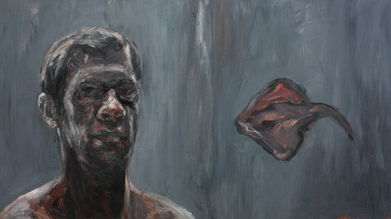JOHANN LOUW
Terugkoms van Cythera
EXHIBITION TEXT
Solo Exhibition
07.02.13 - 23.03.13
Cape Town
SMAC Art Gallery is pleased to present Terugkoms van Cythera (Return from Cythera), a new solo exhibition by Johann Louw. This is Louw’s third major solo show with the gallery.
The materiality of ‘paint as paint’ together with the process of painting itself is significant to Johann Louw. For the artist, as he begins, the object has to be “visually seductive” and encourage a “sensory reaction in terms of both looking and painting” (Louw 2012). In this new body of work, Louw’s physical engagement with the surface becomes “more personal and surreal, tapping into [his] subconscious mind” (Louw 2012).
Terugkoms van Cythera shows a shift away from Louw’s socio-historic themes and a move towards a more enigmatic, introspective and psychological exploration.
Referencing The Embarkation for Cythera (L’Embarquement pour Cythère) (1717) by French Rococo painter Jean-Antoine Watteau, the exhibition serves as an interesting antithesis to the precious celebration of life and love at the birthplace of Venus portrayed in the original painting.
There is a subtle theatricality and cinematic quality to the new works. Louw depicts dreamlike imagery reminiscent of carefully directed stills from a film of which the narrative remains uncertain. Similar to the use of montage in film, Louw juxtaposes seemingly disparate scenes in one pictorial composition. Various objects, animals and anonymous subjects emerge from predominantly grey, abandoned, unspecified and barren spaces – adding to a general sense of unease. This serves to connect multiple thoughts, associations and intense emotions into one dynamic sequence.
Louw states; “there is a balance between a story, the narrative and the images which, because of their juxtaposition, might create a reaction, I cannot foresee what will happen” (2012). As with his previous bodies of work, Louw addresses his and the viewer’s own construction of meaning. We are encouraged to become an active participant as Louw’s purposefully equivocal style of painting demands that we decipher the works’ meanings and mysteries for ourselves.
There is also a continual engagement with the traditions of still life painting. The representation of inanimate objects in Louw’s depiction of animal skulls and bones alludes to the original French term for still life – nature morte (dead nature), suggesting the interest in mortality that runs like a thread throughout the exhibition.
































